 "
"
The opening of the preorbital gland in deer serves as a visual communication and has been linked to a wide variety of behavioural situations. As we reported recently, all previous long-term studies on preorbital gland opening were carried out on only one species, whereas case reports on six other rarely studied species have shown associations with different behaviours, thus greatly increasing our overall understanding of the real function of this gland in animal visual communication.
Here, we report for the first time preorbital gland opening in the barasingha (Rucervus duvaucelii) in social contexts as observed in a wild population in Kanha National Park, India on Nov 23rd and 24th 2014 during the rutting season (which peaks from November to December). We observed this behaviour in two different contexts: agonistic (stressed, combative) and sexual. Moreover, our record of preorbital gland opening during copulation is the first one amongst cervids. Our findings of preorbital gland opening in both contexts in wild barasingha indicate that the gland was opened only when the individual was highly excited. We suggest that preorbital gland opening may be an important behavioural indicator of an individual involved in a serious intraspecific interaction, and thus a useful tool with which to distinguish between playful and serious behaviours, especially in agonistic and sexual situations.
Our research confirms our previous suggestion (Ceacero et al., 2015) that the observation of the preorbital gland in poorly studied species can lead to interesting new findings and a greater understanding of this behaviour in general.
Although only classified as Vulnerable by the IUCN, barasingha or swamp deer (Rucervus duvaucelii) is one of the rarest cervid species in the world (Duckworth et al., 2013). The total population comprises less than 5000 individuals and is split between two wildlife reserves in Nepal and three national parks (NP) in Northern (Dudhwa NP), central (Kanha NP) and North-Eastern (Kaziranga NP) India. Of the 3 subspecies of barasingha, two, R. d. branderi and R. d. ranjitsinhi, have less than 600 individuals each (Qureshi et al., 2004; Duckworth et al., 2013).
Full report: First records of preorbital gland opening in rare wild barasingha (Rucervus duvaucelii) in social contexts may help to explain this phenomenon in cervids: Jan Pluháčeka, Francisco Ceaceroa, Peter Luptákd, Behavioural Processes, Volume 119, October 2015, Pages 28–31.

 CI is a non-profit, non-commercial portal that aims to facilitate wildlife and nature conservation by providing reliable information and the tools needed to campaign effectively.
CI is a non-profit, non-commercial portal that aims to facilitate wildlife and nature conservation by providing reliable information and the tools needed to campaign effectively.
Chosen as 'Picture of the Week'
Our research confirms that the observation of the preorbital gland in poorly studied species can lead to interesting new findings and a greater understanding of this behaviour in general.